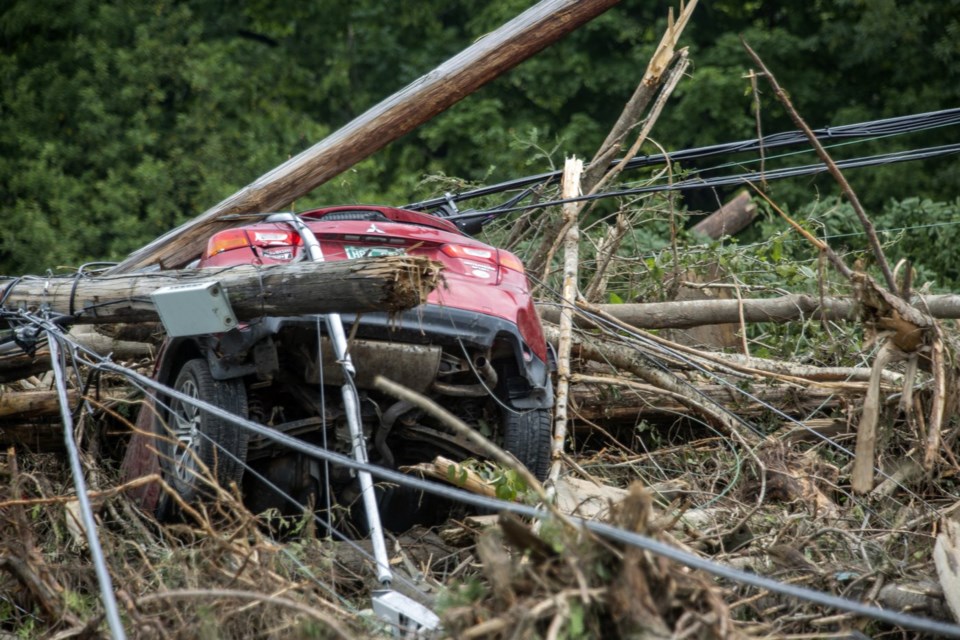LYNDON, Vt. (AP) — Vermont’s governor said Wednesday that the latest storms to hit the state have undone much of the cleanup and recovery work done since its last major bout of flooding only weeks ago, and he called on residents to “stick together” amid fears that more bad weather was on its way.
Thunderstorms on Tuesday brought another round of heavy flooding that washed away roads, crushed vehicles, pushed homes off their foundations and required at least two dozen boat rescues in northeastern Vermont. Some areas got more than 8 inches (20 centimeters) of rain.
More downpours were expected Wednesday, with flash-flooding possible in some already inundated areas, Jennifer Morrison, the commissioner of the Vermont Department of Public Safety, said at a news conference in Berlin, near the state capital, Montpelier. A National Weather Service flood watch was in effect for central and northern Vermont from noon until midnight.
“This time, it’s especially bad after workers spent the past three weeks working furiously to recover from the last flooding,” Gov. Phil Scott said at the news conference. “It feels much worse than a punch or a kick. It’s simply demoralizing. But we can’t give up. We’ve got to stick together and fight back against the feeling of defeat.”
This week’s storms have brought a modicum of the destruction the state endured in early July, when the flooding also killed two people. As of Wednesday, there were no reported deaths caused by the latest storms, but Morrison said “very preliminary information” indicated that 50 homes were destroyed over suffered significant damage. Half a dozen roads remained closed, lightning strike knocked out water for part of the town of St. Johnsbury, and flooding had contaminated several wells that serve the village of Lyndonville, officials said.
“I get more apprehensive with every storm. All of us are watching the weather,” Scott said. With already-saturated soils and already-damaged infrastructure, “this just adds insult to injury.”
Weeks after Jason Pilbin watched a driver get his northeastern Vermont town of Lyndon was ravaged again. He went outside with a flashlight and headlamp around 2:30 a.m. Tuesday to help some neighbors evacuate and then collected their vital medications about 20 minutes before their After that, he woke up another neighbor to help her to leave her home.
, Pilbin watched helplessly as a man drowned after getting caught while driving through flooding caused by the remnants of Hurricane Beryl. “Unfortunately, I wasn’t able to save him, but I was able to save these” people, he said. “I guess that makes up for some of it. It’s been rough.”
Mark Bosma, a spokesperson for the Vermont Emergency Management Agency, said that swift water rescue teams conducted approximately two dozen boat rescues in the hardest-hit areas overnight Monday into Tuesday. There have been no reports of serious injuries or deaths during this round of flooding.
In May, Vermont became the to enact a law requiring fossil fuel companies to pay a share of the damage caused by extreme weather fanned . But officials have acknowledged that collecting any money will depend on litigation against the much-better-resourced oil industry.
Although climate change has its impacts, special calculations are needed to determine exactly how much global warming is to blame, if at all, for any single extreme weather event.
“The flooding in Lyndonville is just highlighting that climate change is here and the damage is ongoing and oil companies have so far not been required to pay for any of the damage that their product has caused and that needs to shift,” state Sen. Anne Watson said Wednesday. “The financial burden is increasingly unbearable by Vermonters.”
In St. Johnsbury, Vanessa Allen said she knew rain was possible, but she wasn’t expecting the deluge.
“This is devastating and was completely unexpected,” she said.
Her home was situated between two road washouts, so she was unable to leave. The roads were pockmarked and covered in debris. Nearby, she said, a house had been moved off its foundation and was blocking a road.
“It looks apocalyptic," she said. “We’re trapped. We can’t go anywhere.”
The state experienced caused by what was left of Hurricane Beryl. The flooding destroyed roads and bridges and inundated farms, and it came exactly a year after a of severe flooding hit Vermont and several other states.
Vermont has experienced four flooding events in the last year, and a combination of and the state’s mountainous geography are to blame, said Peter Banacos, science and operations officer with the weather service. Greater rainfall has made the state and its steep terrain more susceptible to flooding, he said.
The state’s soil is also getting saturated more frequently, which increases the possibility of flooding, Bancos said.
Vermont’s history of heavily manipulating its rivers and streams also plays a role in increased flooding, said Julie Moore, secretary of the Vermont Agency of Natural Resources. The increase is “a reflection of having reached our limits of С����Ƶ able to truly manage rivers and hold them in place,” she continued.
Roads, bridges, culverts and wastewater facilities are all especially vulnerable The state is in the midst of a multi-decade effort to “replace them or refurbish them with our current and future climate in mind,” Moore said.
Vermont is also working to establish statewide .
___
McCormack reported from Concord, New Hampshire. Associated Press reporters David Sharp and Patrick Whittle in Portland, Maine, and Julie Walker in New York also contributed to this story.
Lisa Rathke, Nick Perry And Kathy Mccormack, The Associated Press




